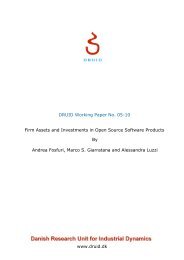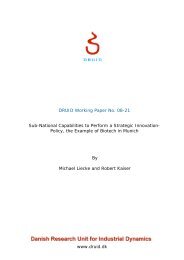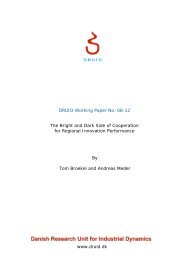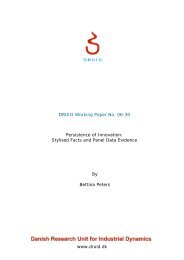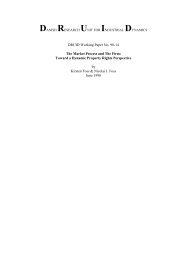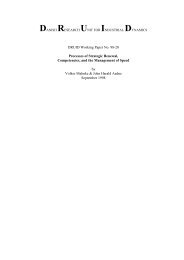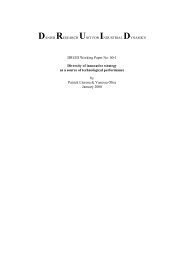danish research unit for industrial dynamics druid working paper no ...
danish research unit for industrial dynamics druid working paper no ...
danish research unit for industrial dynamics druid working paper no ...
Create successful ePaper yourself
Turn your PDF publications into a flip-book with our unique Google optimized e-Paper software.
18an agreement. For this reason, we study firms which do <strong>no</strong>t have reciprocal financial links.Two cases however appear as partial exceptions. First, the case of Renault and RenaultAutomation has been kept because the latter firm increased its independence during the 80'sand became auto<strong>no</strong>mous at the beginning of the 90's. The case of Comau and Fiat was alsokept even if Comau still has a financial link with Fiat, because of the great independence ofComau in terms of tech<strong>no</strong>logical creation.A<strong>no</strong>ther criterion <strong>for</strong> selection of alliances was the desire to analyse agreements whoseoperations had terminated. In this way it was possible to give an overall evaluation of theagreement. This criterion allowed <strong>for</strong> qualitative evaluation of the impact of the agreementon organisational conditions, the nature of the k<strong>no</strong>wledge produced, the <strong>dynamics</strong> oflearning, the nature of assets and their possible redeployability in others agreements. As thenumber of producers in the robotic sector is very small, we were also able to take intoconsideration all agreements or interactions which had taken place be<strong>for</strong>e the alliance.The automobile sector was chosen because car manufacturers have a long-standingcommitment to producing their own equipment, and have thus developed internalcompetencies in the design of robots. Citroën, BMW, Fiat and Renault have played a veryactive role in developing robotic k<strong>no</strong>w-how by beginning to design their own robots in theirplants be<strong>for</strong>e externalising this activity. Most of the users have there<strong>for</strong>e a specificexperience and may be considered in some cases as "lead users" 4 .This specific context helps to have a "history" of <strong>industrial</strong> relations between the firms andto illuminate some particular transfer of k<strong>no</strong>wledge realised in the agreements between thetwo firms. In this context it seems to us interesting to see how learning might be sustainedby these initial conditions and how learning can evolve in a <strong>no</strong>n deterministic wayaccording the nature of assets engaged in cooperation.The content of the agreements may concern the development of various projects. Someagreements concern the development and the implementation of software either <strong>for</strong>monitoring the robot or <strong>for</strong> improving the process by implementing an "off line" systemwhich provides data be<strong>for</strong>e the launching of the car. Some agreements include rathersophisticated opto-electronic developments concerning the robots <strong>for</strong> assembly lines.4 For a longer discussion on this point and some recent illustrations on the role of users in this dynamic, seeKong Rae Lee (1996), Hippel and Tyre (1995), Balconi (1996) and Fleck (1994).



